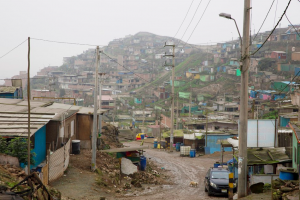This article focused on the border wall in Lima, Peru. The concrete wall divides the cities rich and poor. The building of the wall began in 1985 carving through the rugged terrain. This wall was built to segregate the plywood and metal sheet shacks from the Casuarinas. The Casuarinas were the luxury mansions the cities wealthy. This wall has expanded to keep separating the wealthy neighborhoods from “the other” This article addresses the reasons that this wall was put up as well as personal stories that tell the effect the wall has.
This wall was put in place so that the rich didn’t have to see or experience the life of the slums. The economic disparity is very visible in Lima and all of Peru. This creates “…this idea of security behind the wall that creates homogeneous social groups,”. Further dividing the economic worlds and classes in Peru. about 6.9 million Peruvians live below Peru’s poverty line, that means they earn less than 338 soles ($102) per month. The wall was mainly in response to migration from rural areas in Peru in the 80’s. Because of this migration it caused these pop up houses that weren’t sturdy but they were safe. The wealthy residents of Casuarinas and other areas expanded the wall (this was approved by local government) for safety and to stop the crime spilling into their areas.

This article explained the effect that it had on the people who worked in these wealthy neighborhoods but lived in the slums. one woman Lily Mamani Reyes, a house cleaner has to wake up at 5a.m to begin a two-and-a-half-hour walk to get to work. She puts extra time into this job as a result of the extended commute and yet she says that-her pay has decreased.

Patricia Novoa has lived in the Casuarinas for half her life and said the wall was a security. She explains that the people living theres are criminals and thieves because they have no other choice. That the environment has no education and no way “to live”. This wall has very negative effects on one side and barely registers to the other.
I thought it was interesting that this article mentioned other countries multiple times. It mentioned the US and the current administration. This source is from the Atlantic an American magazine. This was clearly written from an outside perspective. It was very analytical and expressed the position of Peru instead of ways that this issue could be fixed or if theres any though to fixing this. This wall has been up for more than three there should be some sort of action around it. And if there isn’t then why is this being addressed now? and not 30 years ago? We can see a significant segregation of wealth and a visible separation of class in Peru. Connecting this to the topics we have learned in class about Defronzos formula to a revolution this is a clear sign of class/ elite divisions. This also could be connected to mass frustration. Wether Peru will experience a revolution or reform is still unlikely but it is clear that this problem of economic inequality needs to be addressed. Putting a wall between one and their problem will not solve it.
Article: https://www.theatlantic.com/international/archive/2019/09/peru-lima-wall/597085/
